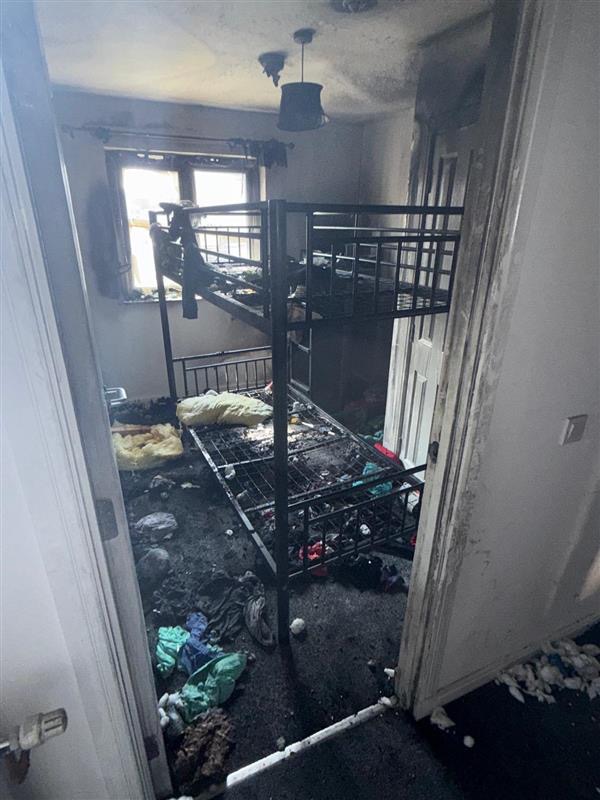
- This event has passed.
Water Mist Activation Saves Scotland Social Housing Property
August 13

Credit Image iMistTM
Summary
This report details a fire which occurred on the first floor of a domestic dwelling, involving a children’s bedroom involving faulty fuel supplies, electricity which ignited mattress and bedding. The fire was contained, extinguished by the activation of the building’s water mist system. There were no reported injuries, the residents successfully self-evacuated prior to the arrival of the Scottish Fire and Rescue Service (SFRS)
In collaboration with the National Fire Chiefs Council, the National Fire Sprinkler Network, and our Automatic Water Suppression System (AWSS) colleagues, Sprinkler Saves UK (The British Automatic Fire Sprinkler Association) collects evidence of such incidents. Supporting our campaign to increase the presence of AWSS within the built environment by highlighting real life, tangible examples of where AWSS were present and had an impact. As such, each of these stories provides powerful evidence of the ability of AWSS protecting our communities from fire.
The outcome of which will provide evidence of the benefits of AWSS, influencing policymakers to implement change, the British Automatic Fire Sprinkler Association, welcomed the government announcement that as of November 2020, sprinklers are now required in all new residential buildings above 11m in height, it remains a concern however that England’s national building and fire safety regulations trail behind its neighbours, governments in other UK jurisdictions for the installation of AWSS.
If it was not for this decision taken by the Scottish Government to initiate legislation to require for all new build social homes, flats and shared multi-occupied residential buildings to be fitted with AWSS from March 2021. the outcome of this incident could have been so different.
1Stuart Stevens, Scottish Fire and Rescue Service Chief Officer, said:
“The Scottish Fire and Rescue Service welcomes the amended regulations and the increased provision of automatic fire suppression systems. This provision is a significant step forward in fire safety and will increase the safety of our communities, residents and firefighters.
The Incident
- On 13 August 2025 at 09:13, three fire engines were dispatched to a reported fire.
- Upon arrival, the incident commander (IC) identified a fire in a bedroom on the first floor of a social housing property consisting of a ground and first floor.
- Following the completion of a dynamic risk assessment by the IC.
- Firefighters wearing breathing apparatus were committed with firefighting media.
- Upon entry to the bedroom, it was established that the fire had been contained, extinguished by the operation of a BS8458 automatic water mist fire suppression system and confined to the room of origin following the activation of a single nozzle.
- Area of premises affected by fire 16m2
- The occupants evacuated the dwelling independently prior to the arrival of the SFRS and no injuries were reported.
- The system was installed and manufactured by iMistTM


Credit Image iMistT
Conclusion
This incident reinforces the benefits of AWSS, in this case water mist which can be used as a form of suppression in buildings where there is an appropriate test protocol in accordance with the relevant standard. Playing a significant role as part of a package of fire safety measures, reducing the impact of fire on people, firefighters, property and the environment.
Sprinkler Saves UK promotes the reporting of all types of fire suppression systems. It is noteworthy to learn about the effective activation of a water mist system which successfully achieved its intended functional objectives.
- Reducing the rate of production of heat and smoke limiting fire growth and ultimately extinguishing the fire.
- Limited the development of the fire to the room of origin, providing valuable time for the occupants to self-evacuate from the building to a place of safety before the arrival of SFRS.
Had the Scottish Government not enacted legislation mandating the installation of AWSS in all new social homes, flats, and shared multi-occupied residential buildings from March 2021, the outcome of this incident might have been markedly different.
BAFSA has published a guide which provides detailed information on the types of water mist systems available, how they can be used and how to choose the most appropriate one for the selected application. Click here to download the guide Water Mist Technical Guide.
Effective advocacy and policy lobbying require the collection of robust supporting evidence. If you have knowledge of a sprinkler incident that may contribute to this initiative, please provide the pertinent details using the sprinkler activation reporting form available at www.sprinklersaves.co.uk.
References, Sources
- 1Scottish Government News, Improved fire safety for new flats and social homes.
- Sprinkler Saves Review 2024/2025
- Sprinkler Saves Winter Update
- iMistTM System Extinguished Childs Bedroom Fire, Keeping Family Safe
- Scottish Fire Rescue Service, Fire Sprinkler Systems
- National Fire Chiefs Council AWSS Position Statement
- Water Mist Technical Guide


